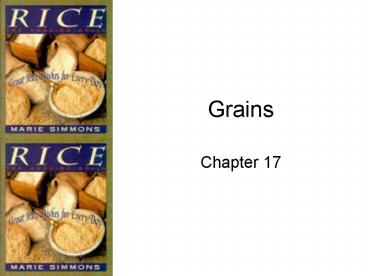Grains - PowerPoint PPT Presentation
1 / 14
Title: Grains
1
Grains
- Chapter 17
2
What are Grains???
- Germ
- Tiny embryo that will grow into a new plant
- Endosperm
- Food supply for a seeds embryo, made up of
proteins, starches, and other nutrients - Bran
- The edible, outer protective layer of a seed
3
Nutrients in Grains
Endosperm complex carbohydrates, proteins, and
small amounts of vitamins and minerals Bran
rich in fiber, B vitamins, and some trace
minerals Germ B vitamins, vitamin E, iron,
zinc, and other trace minerals some protein,
and a small amount of saturated fat
4
Grain Processing
- All grains must be processed, and this begins
with removal of the outer husk. - Whole Grain
- The entire edible grain kernel is used, the
resulting product contains most of the kernels
original nutrients. Examples whole wheat
flour, whole-grain cereals
- When the bran and germ are removed, many
nutrients are lost. Examples include white bread
and most breakfast cereals. When this happens,
the grain products are enriched and fortified. - Enrichment a process in which some nutrients
lost as a result of processing are added back to
the product. - Fortified a process of adding 10 or more of
the Daily Value for a specific nutrient to a
product.
5
Buying Grains and Grain Products
- Choose whole grains
- Buy enriched products
- Low in fat, sugar, and sodium
6
Rice
- Short grained rice
- The grains are almost round. When cooked, the
rice is moist and the grains stick together. - Good for creamy dishes and molded rice rings or
to eat with chopsticks
7
Rice
- Medium grained rice
- The grains are plump, tender, and moist. They
stick together, but not as much as short-grain
rice.
8
Rice
- Long grains
- When cooked, the grains are fluffy and stay
separated.
9
Brown Rice
- Brown rice is less processed than white rice. It
is the whole-grain version of rice.
White Rice
- White rice has the bran and germ removed
Converted Rice
- Rice has been parboiled (briefly boiled) to save
nutrients before the hull is removed.
Instant Rice
- Rice has been precooked and dehydrated. It takes
only minutes to prepare.
10
Other Grains
- Barley mild-flavored, hardy grain, used in
soups and stews - Brans The ground bran of oat, rice or wheat can
be purchased to use as a hot cereals or in
baking. - Bulgur Wheat kernels that have been steamed,
dried, and crushed. Tender with a chewy texture.
Used in main dishes, salads, and as a side dish.
11
Other Grains
- Cornmeal Coarsely ground dried corn, used as a
breakfast cereal and baking - Couscous (KOOS-koos) Steamed, cracked endosperm
of wheat kernel. Has a nutty flaovr and used in
cereal, salad , main dishes, and sweetened for
dessert. - Cracked wheat Crushed wheat berries wsith a
very tough and chewy texture. Often added to
bread. - Grits Coarsely ground endosperm of corn.
- Kasha Roasted buckwheat that is hulled and
crushed. Has a pleasant, nutty flavor. Used as
breakfast cereal or side dish.
12
Other Grains
- Millet Small, yellow grains with a mild flavor.
Used in breads, cereals, or side dishes. - Oats Often eaten as a hot cereal or used in
baked goods. - Quinoa (KEEN-wah) A small ivory colored,
rice-like grain, and cooks faster than rice.
13
Ready-to-Eat and Instant Cereals
- Breakfast cereals are among the largest selling
foods in the U.S. 1billion spent annually! - Choose nutritious cereals! Remember ingredients
are listed by quantity. Avoid cereals high in
sugar!
14
Cooking Principles
- Rice is usually simmered, using just the amount
of water that the grain can absorb. - Boil water
- Add rice
- Cover
- Bring to a boil again
- Simmer
- Follow package directions for amounts and time,
since they vary with the type of rice.

